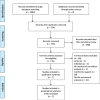Low vitamin D levels are associated with high viral loads in patients with chronic hepatitis B: a systematic review and meta-analysis
- PMID: 31185932
- PMCID: PMC6558894
- DOI: 10.1186/s12876-019-1004-2
Low vitamin D levels are associated with high viral loads in patients with chronic hepatitis B: a systematic review and meta-analysis
Abstract
Background: Previous studies have investigated the vitamin D status in patients with chronic hepatitis B virus (HBV) infection and its relationship with HBV replication, the results however were inconsistent. The present meta-analysis was carried out to compare the vitamin D levels between patients with chronic hepatitis B (CHB) and healthy controls, and to determine whether vitamin D levels were correlated with HBV viral loads significantly.
Methods: A systematic search was conducted via PubMed, Web of Science, EMBASE and the Cochrane Library to identify eligible studies until September 28, 2017. We calculated pooled mean difference (MD) and 95% confidence intervals (CI) to quantitatively estimate the difference of vitamin D levels between CHB patients and controls. In addition, correlation between serum vitamin D levels and HBV viral loads was defined by summary correlation coefficient (r value) and the corresponding 95% CI.
Results: A total of 7 studies involving 814 CHB patients and 696 healthy controls were included. A significantly decreased vitamin D levels was found in CHB patients compared with healthy controls: pooled MD (95% CI) was - 2.03 ng/mL (- 2.60, - 1.46). Latitude-stratified subgroup analysis indicated this difference was more obvious in low latitude areas, with a bigger pooled MD (95% CI) of - 2.72 ng/mL (- 4.57, - 0.87). In addition, we observed an inverse correlation between serum vitamin D levels and HBV viral loads: pooled r (95% CI) was - 0.41(- 0.54, - 0.27).
Conclusions: Our results showed that vitamin D levels were lower in CHB patients than that of healthy controls and inversely correlated with HBV viral loads, although future comprehensive studies are needed to clarify the underlying mechanisms.
Keywords: 25-hydroxyvitamin D; Hepatitis B virus; Hepatitis B, chronic; Meta-analysis; Vitamin D deficiency.
Conflict of interest statement
The authors declare that they have no competing interests.
Figures









References
Publication types
MeSH terms
Substances
LinkOut - more resources
Full Text Sources
Medical

